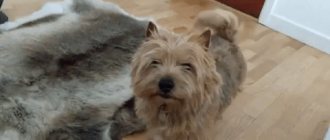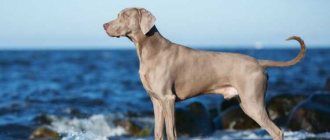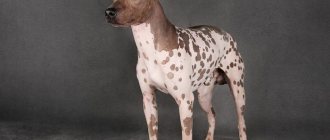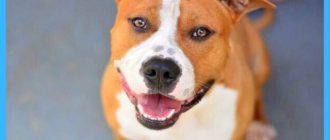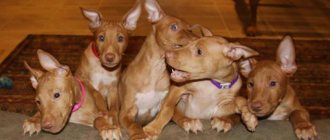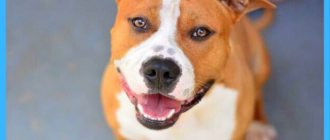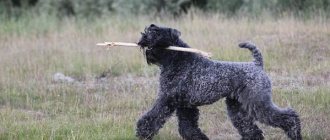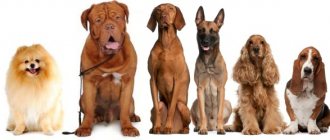The Norwich Terrier is one of the smallest terriers. Dog experts praise the Norwich for taking all the best from this breed.
They are friendly, active, loyal pets. Norwich Terriers are strong dogs in a small body. Not surprising, since the breed was bred for hunting purposes.
At the moment, only in the homeland of Norwich in the UK they are still used in burrow hunting.
After the breed was bred, small terriers lived in kennels and stables. Their task was to exterminate rats and mice. To this day, Norwiches have retained their hunting instinct, but this does not prevent them from being excellent companions for people.
History of the Norwich Terrier breed
The homeland of dogs is considered to be the region of East Anglia, located north of the country's capital.
Here is the county of Norfolk, in whose main city - Norwich - these funny creatures were first spotted. The similarity between Yorkshire terriers and Norwich dogs is no coincidence: the latter descended from English terriers; those, in turn, were bred from Irish and Yorkshire terriers. Speaking about the origin of brave kids, it is impossible not to mention their related Norfolk Terriers. Previously, these breeds were not separated, since the only distinguishing feature of dogs was the shape of their ears. For a long time, terriers participated in a rich breeding program along with representatives of burrowing dog breeds. It was then that the lively little ones acquired their first name - rags. Translated from English, the word rag means “shred, flap.” Probably the reason for such an unpoetic name was the shaggy fur of the animals. Indeed, if a dog’s coat was not tidied up for a long time, it fell off in sloppy shreds.
The next name of the breed turned out to be more presentable and glorified the animals throughout England as skilled rodent hunters. Norwich Terriers were nicknamed Rattlers (from the word “rat”). Despite their modest size and friendly disposition, the dogs successfully coped with the extermination of uninvited guests who raided barns and warehouses. The British increasingly wanted to acquire a charming hunter. With this desire, the popularization of the breed began in the country, and later throughout the world. In the 1880s these terriers became the unofficial mascot of the University of Cambridge. The puppies created a sensation among students who lined up for the fashionable pet. This is how the unofficial name appeared - the Cambridge Terrier.
At the beginning of the 20th century, dog breeder Frank Jones resumed work on the exterior of the “Norwich”, crossing a representative of the breed with Cairn and Glen of Imaal terriers. Later dogs from Market Harborough and Cambridge joined the breeding program. The possible ancestors of modern Norwich Terriers include the Border Terrier. The efforts of breeders were aimed at improving and further developing the brave breed, beloved by many Englishmen.
Animal breeding turned out to be a success in 1932, when the history of the breed was expanded by three significant events at once. The Norwich Terrier took part in a dog show for the first time, and its success led to the emergence of a breed club and recognition of its standard by the Kennel Club of Great Britain. Fuel was added to the fire by the ongoing debate about erect and floppy ears among representatives of what seemed to be the same breed. With the outbreak of World War II, the differences between the two camps subsided. Charming terriers were replaced by service dogs, and small rat catchers found themselves on the verge of extinction.
From the middle of the 20th century, the debate flared up with renewed vigor, since the 1932 standard still considered floppy and erect ears as signs of the same breed. Breeders sought to separate outwardly similar dogs and thereby get rid of possible competition. The British Kennel Club did not consider these differences a reason to create two independent breeds. In 1964, the conflict reached its climax, and the club members gave in. Dogs with erect ears retained the name “Norwich Terriers,” but their fold-eared counterparts were renamed “Norfolk Terriers.”
English rat catchers began colonizing the United States in 1914, when Philadelphia athlete Robert Strawbridge returned to his homeland accompanied by a male dog named Willum. From this dog came the American line of Norwich Terriers. The dogs were often called Jones Terriers, after the man who is considered the founder of the breed. In 1936, thanks to dog breeders Henry Bixby and Gordon Massey, natives of England (with floppy and erect ears) were included in the register of the American Kennel Club under an official name. Following the example of their British colleagues, US dog breeders divided the breed into Norwich and Norfolk terriers in 1979. Separate clubs appeared at the beginning of the 21st century.
Although dogs are no longer used as skilled rodent exterminators, they continue to take over the world. Hairy babies are valued for their easy-going disposition and funny appearance - this is enough to become a desirable pet and loyal friend for many years! The hunting qualities of animals fade into the background.
Health
A healthy, cheerful breed, whose life expectancy reaches 14–15 years, has no hereditary diseases, but is prone to obesity. In the human world, gaining a couple of extra pounds is not viewed as categorically as in the canine world. For an overweight dog, there is a path leading to a whole bunch of diseases, the heart, liver, and hormonal system suffer, and this leads to diabetes. The joints and digestive tract are affected, causing dental problems. There are dozens of similar “chains” and they are all provoked by one disease – obesity.
Another feature worth mentioning is the syndrome that causes breathing difficulties. It is still unknown whether the pathology is hereditary or acquired with age. The disease is expressed by the fact that the dog begins to breathe shallowly, since a full breath brings pain. The body suffers from oxygen starvation, which leads to lethargy, loss of appetite, metabolic disorders and a number of other problems. The syndrome cannot be treated because its causes cannot be determined. To alleviate the animal’s condition, veterinarians resort to relieving obvious symptoms.
Norwich Terrier breed standard
Contrary to misconception, the Norwich Terrier is not a decorative dog breed, although its size is very small even in comparison with other terriers. These animals are squat and compact, but at the same time do not look awkward. The skeleton is strong, surrounded by moderately developed muscles.
Sexual dimorphism is weakly expressed: males and females barely differ in size. According to the FCI standard, the height of the terrier at the withers should reach 24-26 cm, and body weight should vary between 5-5.5 kg.
Head and skull
Most often, the head seems larger than its size, and the reason for this is the “increased shaggyness” of the dog. The format is typical for most terriers: the head is wide, with smooth outlines. The skull is rounded (especially in the ear area), the frontal part seems flattened. The occipital protuberance is moderately expressed.
Muzzle
The Norwich Terrier's muzzle is wedge-shaped. The lengths of the muzzle and head (from the back of the head to the bottom of the foot) are in a ratio of 2:3. The transition between the forehead and the bridge of the nose is quite sharp. The lobe is painted black. Thin lips are fully pigmented and fit tightly to the jaws. No shine is observed. When the mouth is closed, the teeth are not visible.
Ears
Medium size, standing. The “triangles” are located high on the top of the head with a significant distance between them. The ears are raised and directed forward when the dog is excited about something. In a calm state, they are most often slightly laid back. The tips are pointed.
Eyes
The Norwich Terrier's eyes are relatively small, oval in shape and slanted. Due to the anatomical structure of the skulls, they are slightly recessed, which serves as a kind of protective mechanism. Dry eyelids fit tightly to the eyeballs and are pigmented in dark shades. The color of the iris is dark brown or black. Animals have an interested and cheerful look.
Jaws and teeth
The jaws form a regular scissor bite. The teeth are atypically large (considering the dimensions of the Norwich), set firmly and strictly vertically.
Neck
The length of the neck corresponds to the size of the animal. The neck itself is quite strong, the dewlap and scruff are practically not pronounced.
Frame
The body of the Norwich Terrier is rectangular; has a strong, but at the same time very flexible backbone. The chest is formed by arched ribs and is quite narrow, which does not prevent the dog from being used in burrow hunting. The chest is elongated, notable for its good depth to the level of the elbows or below. The horizontal line of the top is formed by a short back, turning into the same loin and sloping croup. The stomach and groin are selected.
Tail
The breed standard allows for moderately docked and undocked variants. The Norwich's docked tail smoothly completes the topline and is notable for its medium length and high set. When in motion, it rushes perpendicular to the ground. The length of the undocked tail is not strictly regulated. From a thick base, the tail gradually tapers to the tip. Carries above the line of the back, ending it.
Forelegs
They look less muscular compared to the rear ones. Developed shoulders are retracted in the direction of the shoulder blades, turning into straight forearms. The elbows are close to the Norwich Terrier's chest. Strong pasterns are characterized by a strictly vertical stance. The paws are round in shape, reminiscent of a cat's due to the well-filled pads. Directed forward regardless of whether the dog is in motion or not. The claws, like those of all burrowing breeds, are strong.
Hind limbs
Wide, with moderately developed muscles. The strong thighs are of medium length, the knee and hock joints have pronounced angles. The latter are located quite low, together with short metatarsals, they provide a strong push. The paws are medium-sized, rounded, “looking” exclusively forward. They have cat-like voluminous pads. The claws are strong, pigmented black or dark brown.
Movement style
The movements of the Norwich Terrier are characterized by a low stroke and a powerful push due to flexible joints. The dog rearranges its hind limbs “in the wake” of its front ones. The topline “carries” parallel to the ground regardless of the speed the animal develops.
Coat
Norwich wool has properties inherent to the breed line: it bristles in all directions, is harsh to the touch, and resembles a thin wire. Around the neck, the guard hair lengthens, forming a “collar”. The head is covered with smooth, short hair, with the exception of the area above the eyes and near the mouth, where “vegetation” in the form of eyebrows, mustaches and beards is noticeable. The undercoat is thick.
Color
Norwich Terriers have three color options:
- reddish – from fawn to rich red;
- black and tan in reddish shades;
- "grizzly" (grayish).
Possible defects
Defects include minor deviations from the standard. Mainly found:
- weak knees or hocks;
- excessively long or curled tail;
- long or thin-boned muzzle;
- round or bulging eyes;
- undeveloped muscles in the neck;
- white points of any size;
- barrel chest;
- “loose” lips;
- straight bite;
- hare's feet;
- amble.
Disqualifying defects include:
- cowardly or aggressive behavior;
- undescended testicles (cryptorchidism);
- excessively docked tail;
- light shade of the iris;
- undershot or undershot.
Appearance
The general idea of the breed is quite similar to the descriptions of all burrow hunters - a small dog with strong bones and a moderately wide chest, squat, as massive and strong as possible. The temperament of hunters is usually described with a slight hint of uncontrollability; in the Norwich standard, a separate sentence highlights the characteristic - not foolish, but active, hardy, purposeful and tireless. Norwich Terriers are one of the smallest representatives of the working class, their maximum weight reaches 5.2 kg and height 26 cm.
Norwich Terrier personality
Representatives of the breed have long earned the love of dog breeders due to their friendly nature. These brave kids know how to stand up for themselves, but rarely get into a “squabble” with their relatives. Norwich Terriers are sociable animals, and therefore need the presence of their owner. Of course, the dog will get used to the work schedule, but putting up with constant absence is a no-no! The terrier will certainly bark protractedly, so be prepared to talk with disgruntled neighbors.
“Norwich” have an amazing sense of the weather in their home and lighten the atmosphere with a funny prank at the right time. Dogs love all family members equally, but they treat their owner with special reverence. Respect for a terrier is not easy to achieve for those with a gentle character, so the breed is suitable only for those dog breeders who can easily take the position of leader in an impromptu pack. The Norwich Terrier is able to distinguish between the intonation and mood of the owner, so it will not create trouble for a person with extensive experience in keeping dogs.
The protective qualities of the breed are still in doubt. On the one hand, little rat catchers are very vigilant and love to bark in response to extraneous sounds. On the other hand, this kind of foresight is “broken” by the friendly disposition of the animal. A terrier would rather wag its tail with joy than charge at a stranger. You shouldn’t expect the dog to frantically guard property: some Norwich Terriers are ready to turn a blind eye to the machinations of a thief in response to affection or a tasty treat. Training with an experienced dog handler will improve the situation, but this terrier still cannot be made into an excellent watchdog. If guarding qualities are important to you, pay attention to other breeds: Giant Schnauzer, Doberman Pinscher or Boxer.
The Norwich Terrier's playful spirit is the main reason why these dogs feel comfortable in families with children. The older the child, the better: the animal will not tolerate disrespectful treatment. The pet will not bare its fangs in response to a random poke, but it will not continue the fun game with its little friend.
Representatives of the breed do not object to four-legged neighbors. Terriers are tolerant of dogs, but they will tolerate the company of cats only if there is no reason for jealousy. It is better to avoid the company of decorative rodents and birds: the hunting instincts of Norwich Terriers do not obey even the strict orders of the owner. Isolation and punishment will also not have the desired effect. The dog will start a real hunt that will end in success - but, unfortunately, not for your little friend.
Please note: Norwich Terriers tend to exaggerate their importance. This feature is fraught with regular clashes between male dogs and larger relatives. If the intervention of a professional dog handler does not help, you should resort to extreme measures: castration (relevant for non-working males).
Representatives of the breed are distinguished by their mobility. Rare walks and lack of physical activity are a direct path to damaged furniture and other destructive entertainment for the Norwich Terrier. Keep your pet busy chasing a ball or frisbee, searching for hidden objects, or navigating an obstacle course. The terrier will happily throw out the pent-up energy and will not bother you with his whims during the rest of the evening.
Application
A barn rat catcher or one whose task is to drive foxes out of their holes. These are its original functions, similar to the Wire and Smooth Fox Terriers .
Nowadays, the Norwich Terrier is basically a loyal friend and intelligent companion of a person.
Of course, he is not the one who can sit in his arms while you walk around the city with friends. He needs movement.
Representatives of this breed are very kind to children. The main thing is that the child does not torture the puppy
Education and training
Since Norwich Terriers are capable of taking a leadership position in the “pack,” it is important to determine the rules of behavior from the first day the pet arrives in the house. First, set the boundaries of the territory where your pet is allowed to be. Do you think that a bedroom or a nursery is an unsuitable place for a dog? Let your Norwich Terrier understand that a closed door is a good reason to stop at the threshold and wait patiently for the owner.
It is important to instill good manners in your pet. During your walk, stop the slightest pursuit of cats or pigeons, and do not allow the terrier to jump on strangers (especially children). Ideally, a pet should not pay attention to passers-by: this will help to avoid accidental conflicts due to dirty paw prints on a stranger’s clothes or shoes.
There is no point in preventing a dog from communicating with its relatives: early socialization is important for representatives of this breed. You should choose only friendly dogs to be your pet's friends. In this case, the age and gender of the animals are unimportant.
It’s worth knowing: dog experts recommend walking the “Norwich” only in the company of burrowing terriers. These breeds are united by a characteristic feature - friendly biting on the face. Other dogs may perceive the “gesture” as a threat, so be prepared to stop the animal fight in a timely manner.
The Norwich Terrier is a breed with above average intelligence, so it is quite easy to train. During the learning process, you should be consistent and patient. A dog can be stubborn despite its desire to please its owner. Arouse your pet's interest in the new team - and training will go like clockwork! Motivate your terrier only in positive ways: treats or praise. Rudeness and cruelty will forever undermine the dog's trust in you.
The main problem of Norwich Terriers is responding to the owner’s call if the animal is passionate about something. A nickname is the last thing you should count on: the terrier will simply ignore it. If possible, do not move too far from your pet or use a leash regularly, especially near busy highways.
Norwich Terriers often participate in freestyle competitions, agility and other types of “dog” sports. In this case, the intervention of a professional trainer will be required. Regular training and encouragement for successfully performed tricks will turn your pet into a real champion!
Which owner is it suitable for?
The Cambridge Terrier is best adopted by more experienced dog breeders, because despite its kind and friendly character, this breed was bred for hunting. Therefore, the owner of this dog must be able to train it well.
Important! Norwich is also suitable for busy people, since, as mentioned above, it tolerates periods of loneliness well.
The physical level of the person who adopts such a terrier must meet the dog’s requirements for activity. You will need to take the Norwich for long, frequent walks, not let him off the leash, and train his hunting skills.
Care and maintenance
In terms of keeping, the Norwich Terrier is a universal breed. The dog feels comfortable both in an apartment and in a private house, however, it is not recommended to put it on a chain or in an enclosure. In the absence of the owner, the Norwich is subject to regular stress, which often results in uncontrollable behavior.
Due to excessive activity, terriers need a daily walk of at least 2-2.5 hours. Dog handlers do not recommend letting your dog off the leash: under the influence of instincts and the excitement of the hunt, a Norwich Terrier can run away and get lost.
Representatives of the breed require careful grooming, largely due to their double coat. It needs to be combed 2-3 times a week in the direction of hair growth. To do this, purchase a wooden comb with long, sparse teeth. It is not advisable to use plastic brushes and combs. They electrify the animal's coat and make it difficult to remove dead hairs. During seasonal shedding, the Norwich Terrier is trimmed (partially or completely). Entrust your pet to a professional groomer if you plan to participate in the exhibition.
Hygiene
Frequent water procedures are highly undesirable, although it is difficult for Norwich Terrier owners to adhere to this recommendation. Dogs do not disdain digging in the ground or actively exploring their surroundings, so their fur regularly gets dirty. Bathe your pet only as a last resort, so as not to disturb the natural oil balance of the skin. To remove surface dirt, use dry shampoo by rubbing it into your dog's coat and brushing thoroughly.
Important: “human” hygiene products are prohibited, because they often provoke an allergic reaction. For water treatments, purchase zoo shampoo for wire-haired dog breeds with a low content of alkalis and acids. During the cold season, it is recommended to use conditioner balm. After bathing, do not forget to dry the terrier's coat and then dry it with a hairdryer.
Proper care of the Norwich also includes a weekly examination of the ears, especially after a hunt. They need to be cleaned at least once a week. Moisten cotton wool with a special product from the pet store, alternating compositions for the prevention of otitis media and mites. Do not penetrate the ear canal deeper than half a centimeter. Wipe the outer ear until the cotton pad comes out clean. Only then should you wipe the ear dry with a lint-free cloth or swab.
Don't forget to examine your Norwich Terrier's eyes as well. After a walk in windy weather, carefully wipe them with a cotton pad soaked in warm boiled water. If there is purulent discharge or excessive lacrimation, you should contact a veterinary clinic - self-medication is strictly prohibited. Buy eye drops only on the advice of a specialist.
The oral cavity is a vulnerable spot for most representatives of the breed. Since the Norwich Terrier's teeth sit in the gums more tightly than usual, the dog needs weekly preventive cleaning. To remove soft plaque, use zoopaste (you can opt for options with flavoring additives). Apply the product to your toothbrush and remove food particles with sweeping movements. Pet stores sell smaller finger attachments that make the procedure easier.
Please note: bad breath from your pet most often indicates the formation of tartar. To remove it, use the services of a veterinarian.
The Norwich Terrier's claws rarely need the owner's attention, but it is still worth getting a special nail clipper. If the dog’s “manicure” does not have time to wear off on a hard surface, cut it off as it grows back. The main thing is not to touch the “living” part of the claw, where the blood vessels pass. Use a nail file to smooth out sharp edges and burrs. Choose options with the lowest grit rating: they grind down claws better.
Feeding
When it comes to feeding, Norwich Terriers are very loyal and rarely suffer from food allergies. Both industrial food and natural menu are acceptable. A combined diet often causes digestive problems and is therefore highly undesirable.
When choosing food for Norwich, choose super-premium or holistic classes with a high content of minerals and vitamins. Dry granules will slow down the formation of soft plaque on the teeth. It is better to treat wet food to puppies, pregnant or lactating bitches, as well as older dogs.
The basis of the natural diet is meat - at least 60% of the total amount of food. Raw or boiled beef with a little fat is best. Cartilage and tendons are acceptable. Meat can be combined with boiled sea fish without bones. It is recommended to dilute the diet with offal, preferably raw heart and boiled beef liver. For porridges, give preference to buckwheat or rice, supplementing it with pureed or finely chopped raw vegetables, and sometimes fruits. Eating vegetable oil daily will improve the condition of your Norwich Terrier's skin, coat and nails. The serving should not be more than 1 tbsp. l.
It is prohibited to include in a natural diet:
- fatty meat (lamb or pork);
- carbohydrate-containing products;
- river fish (in any form);
- products made from wheat flour;
- raw chicken meat;
- berries with seeds;
- food with spices;
- legumes;
- tubular bones;
- whole milk;
- sweets.
The dog's bowl must be filled daily with fresh water - bottled or running, and let it sit for about 6-8 hours. Boiled water can cause urolithiasis.
Vaccinations and susceptibility to disease
The breed is healthy, strong, and has good immunity. On average, Norwich dogs live 13-15 years, and if all the rules of care are followed - up to 18. But among representatives of the breed, skin and eye diseases and hearing pathologies are often found:
- congenital deafness;
- cataract, glaucoma;
- dermatitis, scabies;
- food allergic reactions;
- epilepsy;
- hip dysplasia.
An infectious disease can also undermine the health of a Norwich Terrier. The only measure to prevent infection with dangerous viruses is regular vaccination.
The first vaccination is at 2-2.5 months, when the Norwich puppy stops receiving immunity from its mother’s milk.
They put strains of canine distemper, parvovirus, enteritis, hepatitis, leptospirosis and influenza. At 7 months - rabies.
Once your Norwich puppy turns one year old, all vaccinations must be repeated.
Important! The owner must follow the vaccination schedule. The effect of the drug is limited to 12-18 months, less often – 2 years. All vaccinations are included in the veterinary passport.
Health and disease of Norwich Terriers
Representatives of the breed are distinguished by good health and resistance to colds. Proper housing conditions and a balanced diet will turn your Norwich Terrier into a small copy of the Terminator! Despite the dog’s excellent immunity, certain ailments are more common than others. These include epilepsy and various pathologies of the respiratory system. Often, Norwich Terriers suffer from brachycephalic syndrome, when a hypertrophied soft palate prevents free breathing.
Remember: routine vaccination is the key to your pet’s longevity! The first vaccination is given at 2 months of age, followed by revaccination after 3 weeks. At six months, the “Norwich” is vaccinated against rabies, not forgetting the complex vaccine against parainfluenza, plague, adenovirus and parvovirus. The latter involves revaccination once a year.
Pros and cons of the breed
The decision to have a pet in the form of a Norwich Terrier is not enough; you still need to sensibly weigh your options. Representatives of the breed are extremely active and mobile, the owner must match this pace of life.
The Norwich Terrier is a rather rare and expensive dog. Check out its main pros and cons.
Advantages:
1. Intelligence and intelligence. 2. Suitable for apartment maintenance. 3. Can handle loneliness without problems. 4. Doesn't bark for no reason. 5. Gets along with children. 6. Has no habit of starting fights with other dogs. 7. Loyalty, friendliness, playfulness.
How to choose a puppy
You can buy a healthy baby with good heredity only in an official nursery. Ask the breeder about his successful experience in breeding Norwich Terriers, the conditions in which the dogs are kept, their titles and awards (if relevant). It is quite difficult to determine by eye whether a puppy meets the breed standard, so it is worth using the services of an expert. It will protect you from purchasing a discarded Norwich Terrier that will not be able to participate in exhibitions.
Before meeting the puppies, it is worth meeting their parents. A few minutes of communication will be enough for a superficial overview of the shortcomings of adult dogs. If a bitch and a dog show cowardice or even aggression, growl in warning and do not make contact, refuse to purchase babies from these producers. It will be extremely difficult to raise docile pets from their puppies.
Norwich Terriers are put up for sale at 7-12 weeks, when they no longer need maternal care and respond adequately to the presence of other living creatures. Among all the kids, choose the most active and strong one, with an excellent appetite and a desire to learn about the world around them. A healthy puppy's coat should be shiny, its nose should be moist, and its eyes and ears should be clean. At the age of 2-3 months, the “Norwich” already has noticeable general body proportions, the position of the tail and ears, the color and structure of the coat.
When choosing a pet, be guided by the gender of the animal. Bitches can boast of a more good-natured and calm character, in contrast to wayward and disobedient males.
When buying a Norwich Terrier, it is important to receive the accompanying documentation: a veterinary passport and medical certificates indicating deworming and vaccination. Owners of show-class dogs will need a breeding certificate indicating the pedigree of the animal.
Nutrition
Each owner decides to feed the dog natural products or special food. Veterinarians advise giving preference to the second method. Since the manufacturers have done a good job on the composition of the feed.
They made the food balanced and filled it with essential vitamins, calories and minerals. In addition, the food is already prepared food, which means there is no need to waste time preparing food for the Norwich Terrier. This saves a lot of time.
But if the owner feeds his pet with natural products, then he must carefully monitor not only the freshness and quality of the products, but also the amount of nutrients, vitamins, and minerals that enter the dog’s diet. The daily menu for the Norwich Terrier contains:
- Lean meats. It is advisable to boil it. But pork should not be given in any form, as it is too heavy food for the Norwich's stomach.
- Fruits.
- Vegetables.
- Buckwheat and rice. Other cereals can also be given, but these are the ones that will have the maximum effect.
- Low-fat cottage cheese, kefir and other fermented milk products.
- Vitamin complex.
Norwich Terrier owners should know that they should not give milk, potatoes, baked goods, flour products, bones, or sweets to their pets. Since the dog’s stomach has difficulty digesting foods that are not intended for it.
In order for your dog to live many years and remain in good health, you need to feed it correctly. To do this, you can consult with professional breeders who can accurately create a diet for the Norwich Terrier. Kennel or private home does not matter where the dog lives. You need to follow her correct diet anywhere.
Norwich Terrier price
The cost of a pet is determined by its age and gender. Young dogs are more expensive than adult dogs, and males are often cheaper than females. Breeders are slightly inferior in price if there are noticeable discrepancies in the appearance of the Norwich Terrier with the breed standard. On average, the cost of a brave rat catcher reaches 35,000 - 50,000 rubles (depending on the characteristics of the animal). Those coming from bird markets and pet stores are much cheaper, but at the same time there is a high risk of acquiring a watchdog of an unknown breed. In the case of the Norwich Terrier, this is unacceptable: every dog breeder should get to know the remarkable charm of the brave little one!
What to feed?
Meat products are the best food for dogs. But you can’t feed her exclusively meat. You need to include fish, dairy products, and cereals in your diet.
Vegetables and fruits are not included in the daily diet of the wild ancestors of dogs, but to enrich the diet with vitamins, they should sometimes be included in the menu.
In order not to waste time and effort on preparing food from natural products, you can offer your pet dry or wet food, which already contains everything necessary.
With proper care and feeding with natural products, the Norwich Terrier will live for 15 years.
Teaching a dog non-standard commands
Agility, advanced tricks, rallying and obedience training give the Norwich the mental stimulation needed for good behavior.
The Norwich Terrier is a working breed and excels at its work. Whether for competition or just for fun, Norwich Terriers participating in these activities will receive the physical and mental stimulation they need to be happy and healthy.
Breed characteristics
| Short description | |
| Origin: | England |
| Conditions of detention: | In an apartment/in a house |
| Purpose: | Companion, hunter |
| Color: | Grey, solid black, fox or grizzly |
| Wool length: | Short, tough; there is a collar in the neck area |
| Adult dog size: | Height up to 25 cm, weight ranges up to 5.5 kg |
| Average life expectancy: | 12-15 years |
| Walk: | Required 2 times a day/training to the tray is practiced |
| Physical activity needs: | Moderate, requires intense, active outdoor play |
| Fédération Cynologique Internationale (FIC) classification: | Recognized by the FCI in 1954, Group 3 Terriers; Section 2 – small terriers |
| Puppy price: | The price is in the range of 40-80 thousand rubles and depends on the pedigree |
Distinctive features
The Norwich Terrier has the following breed standards:
- The head is round in shape and quite wide.
- The stop is clearly defined.
- The muzzle is wedge-shaped, slightly elongated, and short relative to the skull.
- Lips tightly fitting.
- The jaws are powerful.
- The teeth are strong, bite .
- The eyes are dark brown, almond-shaped, relatively small, with a lively, perky, well-recognized shine.
- The ears are erect, high set, triangular in shape.
- The neck is short and massive.
- The body is strong, lean, and the structure is athletic.
- The back is short, the top line is straight.
- The limbs are short, muscular, and the stance is straight; paws - cat type.
- The tail is of medium length, tapered at the end. Moderate docking is acceptable (no more than 2/3 of the tail length).
- The coat is short and harsh; There is a collar in the neck area.
- The color is gray, solid black, fox or grizzly color.
- Movements are fast and energetic.
Key points in training
Norwich Terriers are exceptionally intelligent and quick-witted. In general, they are easy to train and respond well to training. When mastering commands, great attention must be paid to ensuring that classes are regular.
Animals willingly perform active tasks, play and compete. Practicing passive commands such as “ sit ” and “ lie down ” can be difficult. Norwich Terriers can resist and disobey demands. The right decision for the owner will be persistent and persistent repetition of the command until the dog begins to carry it out correctly the first time.
Read about how to properly train a dog in the article: “Training a puppy: effective methods from dog handlers, learning commands at home.”
Description and features
The Norwich Terrier breed is one of the best hunting dogs. The main specificity of its representatives is their impeccable sense of smell. An animal can easily figure out the location of a rat, mole or bird, even those located several hundred meters away from it! This is amazing.
The dog knows that each type of animal has a special smell, so it is trained to catch specific representatives of the fauna. She is good-natured and cheerful, always strives to please her owner, so she never gives up.
The second feature of the breed is the complete absence of fear. Shaking knees, drooping ears in embarrassment, a tucked tail - all this does not at all describe the swift and brave burrow hunter.
Yes, he is small, but very brave. However, a dog, like any other intelligent creature, has an instinct of self-preservation. He will not aggressively attack, for example, a tall and massive Alabai without a specific reason.
Why is Norwich a great hunter? Firstly, he has an amazing ability to navigate in space. Leave him in any terrain and he will definitely get out. Secondly, the dog has an impeccable sense of smell and the ability to identify the smell with a specific living creature.
Well, and thirdly, he is not characterized by a banal search for prey in the forest. Such a dog can not only climb into holes, but also tear them apart. If she wants to catch a specific living creature, there is definitely no hiding place for it.
This is not to say that this beast is bloodthirsty. He was brought out to serve man. That is, he is looking for a small animal, because he knows that it will be useful to its owner. These four-legged pets are rarely kept for hunting these days. Their good-natured disposition won more than one heart.
Skillful and active dogs are loved for their sociable qualities, and the Norwich Terrier definitely has them. In addition, the cute appearance of such a dog served as a reason for keeping it in apartments in many families. She is loved and regularly registered to participate in various competitions and exhibitions.
